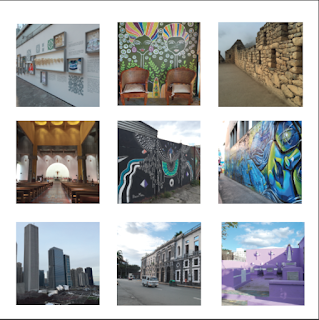Monday, February 27, 2017
Sunday, February 26, 2017
Title Case Recap
Title Case is a typographic design company cofounded by
Jessica Hische and Erik Marinovich. Based in San Francisco, with a custom gold
leaf lettering sign at their front entrance, Hische and Marinovich spend their
days in the studio designing new typefaces. Hische is a letterer, illustrator
and “type nerd.” Hische has worked on several projects, and created a project
called the Daily Drop Cap that would inspire her to create new letterforms
daily. Hische firmly believes that a letterer should be staring at
letters for a long time and creating letterforms consistently. Marinovich is
likewise a letterer, but he also a designer. Seen by the endless amount of
tracing paper found in his workspace, it is clear that Marinovich takes a much
more hand drawn approach to creating his letterforms. Marinovich has a lot of
experience working for big names, such as The Atlantic and The New York Times.
Marinovich emphasizes that sometimes what can be a random choice for a design idea
can sometimes work out in a designer’s favor, such as being chosen for a title
page of a magazine, like Marinovich’s experience with The Atlantic. Hische and
Marinovich occasionally host workshops at their studio in order to emphasize
the importance of lettering and design. Both Hische and Marinovich believe that
the relationship between lettering and the ornament is very important. Title
Case is a space that embraces the idea that type is key to good design, as type
strengthens the artist’s ability to hone in on the minute details and bring
them to life.
Wednesday, February 22, 2017
Saturday, February 18, 2017
Wednesday, February 15, 2017
Sean Adams Recap
Sean Adams, the President of the American Institute of Graphic Arts, provides insight on many topics pertaining to graphic design and the graphic design industry. In the interview presented in class, Sean Adams discusses the history of AIGA, his experience as a teacher, the techniques that aid in forming ideas for design and the tools to get started in a career in design, to name just a few of the topics discussed.
AIGA began in 1914 and currently has 25,000 members and 66 chapters across the United States. The AIGA has expanded since and has now opened a space in the Middle East. Adams really stresses the importance of creating space for permanent archives for artists. These archives allow artists to see and integrate ideas from history into contemporary designs.
Adams is a firm believer in the idea that you don’t choose design, but rather design chooses you. Despite the fact that Sean Adams is a professor at the ArtCenter, he doesn’t necessarily believe that a degree in Graphic Design will make you successful. His design-chooses-you mentality suggests that building a good, simple portfolio is highly important. A good understanding of typography is key in becoming a hirable graphic artist.
Sean Adams continues on to discuss the techniques he uses to come up with good ideas. The first thing he mentions is to listen to the client, as they do not always know how to articulate their ideas. This is the point where the artist chimes in. Relentlessly writing things down and thinking outside of the box for design ideas is also stressed. Adams also discusses the importance of learning design history. Knowing the history adds to the artist’s language, and seeing older methods can be helpful in solving contemporary design problems.
Last for my recap, Adams discusses the importance of networking in the graphic design industry. The graphic design industry is small, and it is extremely important to become involved in the art community and AIGA. Keeping up current trends, especially by researching websites and discovering the plethora of links that each website offers, is also a great way to stay involved in the world of graphic artists.
Thursday, February 9, 2017
Subscribe to:
Comments (Atom)












